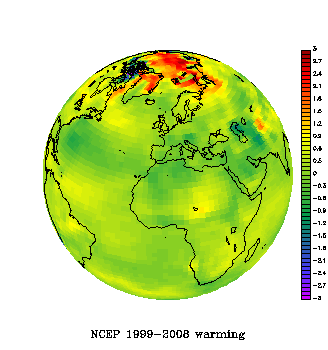RealClimate has a great post, “Mind the Gap!” that explains some of the confusion about recent temperature trends.
Two key datasets, from the U.K.’s Hadley Centre and NASA show warming, as I’ve noted before. But “there are no permanent weather stations in the Arctic Ocean, the place on Earth that has been warming fastest. The Hadley record simply excludes this area, whereas the NASA version assumes its surface temperature is the same as that of the nearest land-based stations.” Even so, the Hadley data clearly show the planet is warming.
It is possible to reconstruct the recent warming in the Arctic and use that to fill in the gaps. The National Weather Service’s National Centers for Environmental Prediction (NCEP) has done just such a reanalysis:
As RealClimate explains: “The animated figure shows the temperature difference between the two 5-year periods 1999-2003 and 2004-2008. Such results do not show the long-term trends, but it’s a fact that there have been high temperatures in the Arctic during the recent years.”
RealClimate further notes that “the low Arctic sea-ice extent over the last summers are independent evidence of high Arctic temperatures.”
If three decades of dawdling had left us any time to convince the unconvinced deniers and delayers, you might say wait for the next decade, which is likely to see truly soaring temperatures, painfully obvious for all to feel.
But the planet’s warming continues unabated, and the time to act is now.
This post was created for ClimateProgress.org, a project of the Center for American Progress Action Fund.


